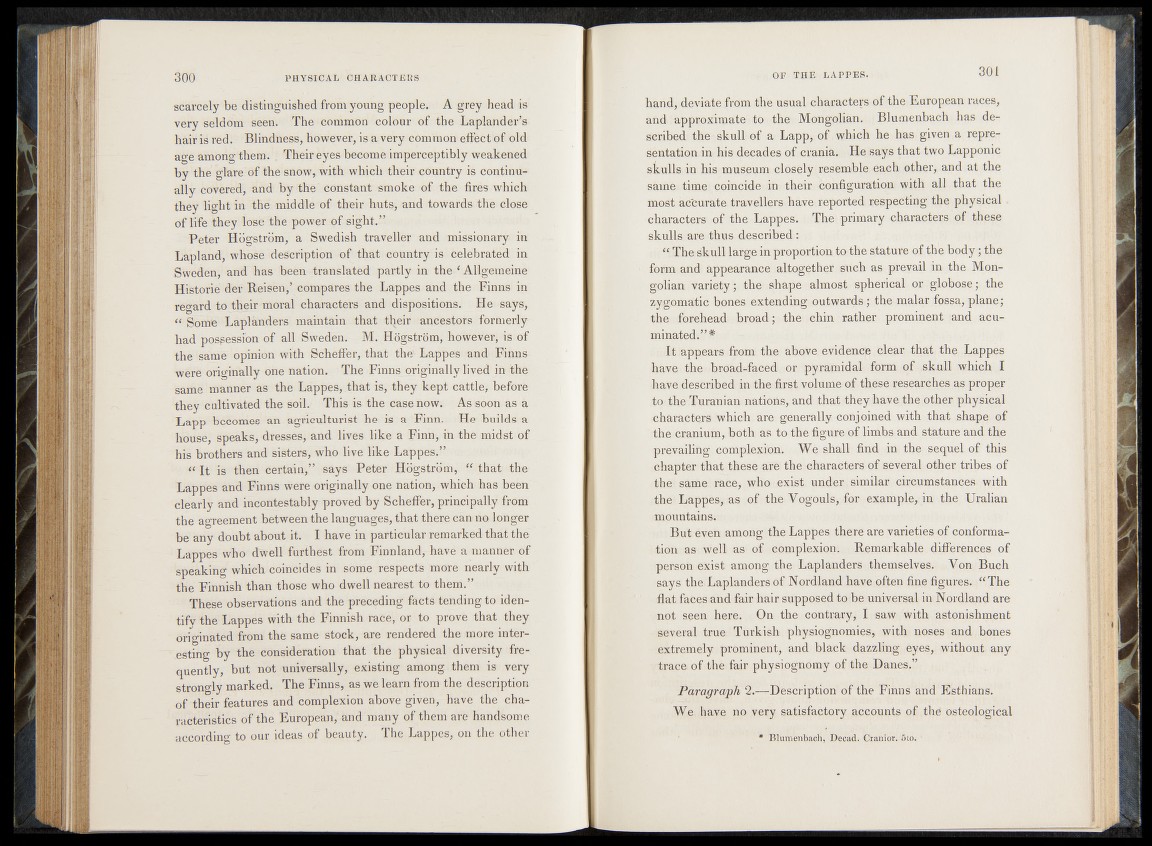
scarcely be distinguished from young people. A grey head is
very seldom seen. The < common f colour of the Laplander’s
hair is red. Blindness, however, is ajveiytdliu&on effect'of bl'd?
age amoiig th em .T h e ir lyes become imperceptibly weakened
by the glare of the?snaw, with which their country *|S continue
ally covered, and by the constant smoke of the fires which
they light in the m id d le d their hut^ and towards the close
of life they lose the power of sight.”
Peter Hbgstrom, a Swedish traveller and missionary inf
Lapland, whose description of that* country.'is celebrated in
Sweden; and has been translated partly in the. ‘ Allgetneine
Htetofie der Reisen,’ compares the Lappes and the; Finns in
regard to their moral characters and dispositions. lie says,
“ Some Laplanders maintain that their ancestors formerly
had possession of all Sweden. M. Hogstrom, however; is of
the same opinion with Scheffer, that the' Lappes and . Finns
Were originally ohe nation. The Finns originally lived in the
same manner as the Lappes, that is, they kept cattle, before
they cultivated the soil. This is the case now. AmsoonJas a
Lapp becomes an agriculturist he is a "Finn. He builds a
house, speaks, dresses, and lives like a Finn* in the midst of
his brothers and sisters, who live like Lappes.”
“ It is then certain,” says Peter Hbgstrom, = ^ th a t the-
Lappes and Finns were originally one nation, which: has been
dearly and incontestably proved by Scheffer, principally from
the agreement between the languages, that there can no. longer
be any doubt about it. I have in particular remarked that the-
Lappes who dwell furthest from Finnlandy have a manner of
speaking which coincides in some respects more nearly with
the Finnish than those who dwell nearest to them.”
These observations and the preceding facts tending to identify
the Lappes with the Finnish race, or to prove that they
originated from the same stock, are rendered the more interesting
by the consideration that the physical diversity frequently,
but not universally, existing among.them is. very
strongly marked. The Finns, as we learn from the description
of their features and complexion above given, have the characteristics
of the European,’ and many of them are handsome
according to our ideas of beauty. The Lappes, on the other.
hand, deviate Trom the usual characters of the European races,
and approximate to the Mongolian. BJumenbach has described
tfiieskull*>@f a Lapp,!of.which he has given.a repre-
Sentation in his decades, of crania. He says that two Lapponic
skulls in his museum closely ; resemble each other, and at the
same timet coincide-4n their configuration with all that the
most- accurate travellers have* reported, respecting the physical.
charact#i of the Lappes. Theiprimary characters, of these
skulls,are thus described; ;
■ ‘VThe skull large in proportion to the stature of the body; the
form .and appearance altogether, sdch a& prevail in the Mongolian
variety';!the shape almost spherical or,-globos^; the
zygomatic bones .extending» outwards; the^malar fossa, plane;
the forehead broad; the jehin* rather prominent ;and acuminated^”
*
It jappears from the above exftdencp clear that, the Lappes
have the bröhd-faced ordpyrahiidal form ;of yskujl which I
have described in the first volupe of these researches as proper
to^ the Turaniamna-tfons, and that »they have the,other physical
jfehitetact^ri 'which are generally con|oined with that shape of
.»the cranium, both as to the figure of limbs and stature and the
prevailing, complexion. We shall find •im the.,s^^^l of this,
ohapterthat these are the characters of several<,othei»(tribes.of
the- same; race, who-exist undent similar circumstances with
the Lappes, as of* the .Vogouls, for example, in the Uralian
mountains.
ii But even.among the Lappes there are varieties of conformation
as well as of complexion;; . Remarkable differences of
person exist amongs the Laplanders themselves. Von Buch
says the. Laplanders ofNordland have often fine figures, 4 The
flat faces and fair hair supposed to be universal in;;Nordland are
not seen here. On, .the^ contrary, I saw with .astonishment
several true Turkish, physiognomies, with noses and. bones
extremely prominent; and black dazzling, eyes, without any
trace of the fair physiognomy of the Danes.”
Paragraph 2.—Description of the Finns and Esthians.
We, have no very satisfactory accounts of thé osteological
* Blumenbaeli, Deead. Cranior. !5,tdjv >